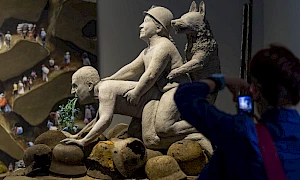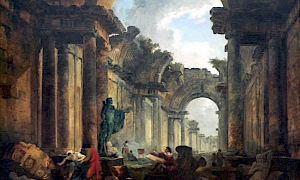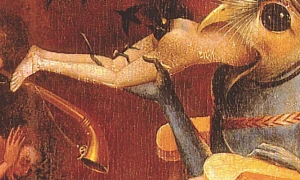Are Museums Free?

William Hogarth, The Battle of the Pictures, 1743.
Our ecosystem is the iconosphere.1 We perceive and understand reality through images, and nobody doubts their centrality to our understanding of the world. And yet their importance does not lay in accurately depicting our surroundings or in revealing the intricacies of power, but in being the means by which and for which different powers settle their forces. As William Hogarth anticipated in this famous 1743 engraving The Battle of the Pictures, the present is characterised by a constant conflict between representation and appearance.
It would seem that by this point in the twenty-first century, there is no particular content or form that is problematic for the majority of people. In fact, even though they often describe wretched circumstances and individuals or shocking situations, some supposedly critical art practices actually favour consensus and contribute to the numbing of society. Communication strategies calculate scandal down to the last millimetre: it serves to focus the gaze and boost sales, it does not question a system of values that is dominated by the market.
Are museums free? Is there such a thing as genuine freedom of expression? The governance principles and codes of ethics of organisations such as CIMAM and ICOM appear to guarantee guidelines that ensure all agents can perform their roles freely and independently: trustees act as trustees and do not interfere with academic or curatorial decisions, artists carry out their work without coercion, and audiences enjoy the material presented to them in an environment favourable to active involvement, not consumption. If these maxims were clearly enforced, a museum could work free of restrictions of any kind.
CIMAM and ICOM are international agencies whose structures and functions are essentially the same as those of the other institutions imagined by liberal modernity. These organisations are based on the separation of powers and on an idealistic idea of society, and position themselves beyond our lives and outside of history. In keeping with this idea, the museum would be a kind of neutral receptacle with room for all things artistic, but only those that are artistic or defined as such at a particular moment in time. The only measure required to sanction their operation would be compliance with a set of universal rules. Any disruption could only be due to an incorrect use of their logic, either because the country in which the museum is located has not yet attained sufficiently 'democratic' structures, or because its users or artists have not yet clarified their actions and experiences. Although it is true that there have been relatively few cases of direct interference in museums in recent years, it is equally true that a managerial approach has been imposed, in which everything is measured in terms of the bottom line. Artistic projects are not evaluated according to aesthetic or educational criteria; processes do not matter, only management efficiency and the capacity to generate financing. This means that public institutions are usually confined within a complex bureaucratic apparatus that tends towards banality, towards preserving existing procedures and ensuring legal orthodoxy, rather than towards promoting innovation or the capacity to bring about shifts and imagine new worlds. And we should not forget that following 11 September 2001, neoliberalism entered a militarised phase that simultaneously set off a widespread fear of the enemy without, and a deep insecurity concerning aggressive forms of surveillance within the country. The social and employment precariousness provoked by the crisis in 2008 has intensified this fear and driven some sectors of the fragile arts ecosystem to take conservative positions –if not actual self-censorship– in an attempt to avoid anything that threatens their survival and our place in it. The so-called 'culture wars' of the eighties in the USA were paradigmatic in this sense. We know that quite a lot of museums stopped programming exhibitions containing explicit images of sex, criticism of religion, or certain political stances.
All communities conceive their own forms of organisation and arrange them in such a way as to better apprehend the world they live in and organise around. Institutions are built in accordance to inherited ideas that settle over time and condition the way we live together and interact: we inhabit our institutions as much as they inhabit us. But societies are not static, they are agonistic. They are constituted through the interplay of a series of forces that are mutually antagonistic, striving to reach a hegemonic position and overthrow a power that does not necessarily represent the majority, even if it is dominant.
Like other social structures, museums are not agencies that are established once and for all. Their nature is agonistic. They are places that we occupy with a clear will to transform. But are museums in harmony with the more progressive aspects of contemporary art, or have they adapted to the pressures of an ever more voracious market? Do they address the demands of society? And if so, what sectors of society: those that wield economic power, those that hold political power, or those that are still without a voice? Well into the twenty-first century, the museum is still at a crossroads.
There is no doubt a great deal of effort is required to make any real change in a museum against the status quo, and that even when a change is made it is unlikely to survive if left alone, out of sheer inertia. Reality is stubborn, and we have seen many museums that managed to attain considerable levels of critique and independence eventually return to positions that they would have appeared to have moved beyond. The most recent example is the events at MACBA. A series of actions were all it took to show that things are not as clear as we thought, and to reveal the strange links between culture and power. When a museum has authority, it may enjoy a very high level of autonomy, and that is the moment in which to implement anomalous structures, devices and narratives that resist absorption and generate spaces of freedom and antagonism.
In the MACBA case there may not have been direct pressure from the management or members of the board. It wasn't necessary. The director ended up turning himself in for a crime that, in this case, he had not yet committed. Censoring in order to avoid being censored. The problem does not lie in the actual censorship, so much as in the fact that it is a symptom of a more complex battle. The solution lies in generating and stimulating new institutional forms that interpellate the museum from without, creating spaces that enable the empowerment of audiences, the museum's active involvement in the city, the reconsideration of official narratives, and, as Edouard Glissant puts it, an 'oral' way of understanding history and the collections that hinders commercialisation. These are the challenges and the strength of the museum.
Translated from Spanish by Nuria Rodríguez Riestra



